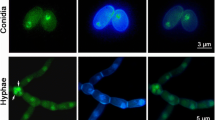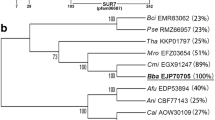Abstract
Sho1 is an important membrane sensor upstream of the HOG-MAPK signaling pathway, which plays critical roles in osmotic pressure response, growth, and virulence in fungi. Here, a Sho1 homolog (MaSho1), containing four transmembrane domains and one Src homology (SH3) domain, was characterized in Metarhizium acridum, a fungal pathogen of locusts. Targeted gene disruption of MaSho1 impaired cell wall integrity, virulence, and tolerances to UV-B and oxidative stresses, while none of them was affected when the SH3 domain was deleted. Intriguingly, disruption of MaSho1 significantly increased conidial yield, which was not affected in the SH3 domain mutant. Furthermore, it was found that deletion of MaSho1 led to microcycle conidiation of M. acridum on the normal conidiation medium. Deletion of MaSho1 significantly shortened the hyphal cells but had no effect on conidial germination. Digital gene expression profiling during conidiation indicated that differential expression of genes was associated with mycelial development, cell division, and differentiation between the wild type and the MaSho1 mutant. These data suggested that disruption of MaSho1 shifted the conidiation pattern by altering the transcription of genes to inhibit mycelial growth, thereby promoting the conidiation of M. acridum.






Similar content being viewed by others
References
Ahearm DG, Price D, Simmons RB, Mayo A, Zhang ST, Crow SA Jr (2007) Microcycle conidiation and medusa head conidiophores of aspergilli on indoor construction materials and air filters from hospitals. Mycologia 99:1–6
Anderson JG, Smith JE (1971) The production of conidiophores and conidia by newly germinated conidia of Aspergillus niger (microcycle conidiation). J Gen Microbiol 69:185–197
Bosch A, Yantorno O (1999) Microcycle conidiation in the entomopathogenic fungus Beauveria bassiana Bals. (Vuill.). Process Biochem 34:707–716
Braga GUL, Flint SD, Miller CD, Anderson AJ, Roberts DW (2001) Variability in response to UV-B among species and strains of Metarhizium anisopliae isolates from sites at latitudes from 61°N to 54°S. J Invertebr Pathol 78:98–108
Chen RE, Thorner J (2007) Function and regulation in MAPK signaling pathways: lessons learned from the yeast Saccharomyces cerevisiae. Biochim Biophys Acta 1773:1311–1340
Cullen PJ, Sabbagh W Jr, Graham E, Irick MM, van Olden EK, Neal C, Delrow J, Bardwell L, Sprague GF Jr (2004) A signaling mucin at the head of the Cdc42- and MAPK-dependent filamentous growth pathway in yeast. Genes Dev 18(14):1695–1708
Du YR, Jin K, Xia YX (2018) Involvement of MaSom1, a downstream transcriptional factor of cAMP/PKA pathway, in conidial yield, stress tolerances, and virulence in Metarhizium acridum. Appl Microbiol Biotechnol 102(13):5611–5623
Ekesi S, Maniania NK, Lux SA (2003) Effect of soil temperature and moisture on survival and infectivity of Metarhizium anisopliae to four tephritid fruit fly puparia. J Invertebr Pathol 83:157–167
El-Ganiny AM, Sheoran I, Sanders DA, Kaminskyj SG (2010) Aspergillus nidulans UDP-glucose-4-epimerase UgeA has multiple roles in wall architecture, hyphal morphogenesis, and asexual development. Fungal Genet Biol 47(7):629–635
Etxebeste O, Herrero-García E, Cortese MS, Garzia A, Oiartzabal-Arano E, de los Ríos V, Ugalde U, Espeso EA (2012) GmcA is a putative glucose-methanol-choline oxidoreductase required for the induction of asexual development in Aspergillus nidulans. PLoS One 7(7):e40292
Façanha AL, Appelgren H, Tabish M, Okorokov L, Ekwall K (2002) The endoplasmic reticulum cation P-type ATPase Cta4p is required for control of cell shape and microtubule dynamics. J Cell Biol 157(6):1029–1039
Fang WG, Pei Y, Bidochka MJ (2006) Transformation of Metarhizium anisopliae mediated by Agrobacterium tumefaciens. Can J Microbiol 52(7):623–626
Gao Q, Jin K, Ying SH, Zhang YJ, Xiao GH, Shang YF, Duan ZB, Hu X, Xie XQ, Zhou G, Peng GX, Luo ZB, Huang W, Wang B, Fang WG, Wang SB, Zhong Y, Ma LJ, St Leger RJ, Zhao GP, Pei Y, Feng MG, Xia YX, Wang CS (2011) Genome sequencing and comparative transcriptomics of the model entomopathogenic fungi Metarhizium anisopliae and M. acridum. PLoS Genet 7(1):e1001264
Gu Q, Chen Y, Liu Y, Zhang C, Ma Z (2015) The transmembrane protein FgSho1 regulates fungal development and pathogenicity via the MAPK module Ste50-Ste11-Ste7 in Fusarium graminearum. New Phytol 206(1):315–328
Hanlin R (1994) Microcycle conidiation — a review. Mycoscience 35(1):113–123
Hohmann S (2009) Control of high osmolarity signalling in the yeast Saccharomyces cerevisiae. FEBS Lett 583(24):4025–4029
Jin K, Ming Y, Xia YX (2012) MaHog1, a Hog1-type mitogen-activated protein kinase gene, contributes to stress tolerance and virulence of the entomopathogenic fungus Metarhizium acridum. Microbiology 158(Pt 12):2987–2996
Jung B, Kim S, Lee J (2014) Microcyle conidiation in filamentous fungi. Mycobiology 42(1):1–5
Labedzka K, Tian C, Nussbaumer U, Timmermann S, Walther P, Müller J, Johnsson N (2012) Sho1p connects the plasma membrane with proteins of the cytokinesis network through multiple isomeric interaction states. J Cell Sci 125(Pt 17):4103–4113
Lanver D, Mendoza-Mendoza A, Brachmann A, Kahmann R (2010) Sho1 and Msb2-related proteins regulate appressorium development in the smut fungus Ustilago maydis. Plant Cell 22(6):2085–2101
Lapaire CL, Dunkle LD (2003) Microcycle conidiation in Cercospora zeae-maydis. Phytopathology 93:193–199
Liu W, Zhou X, Li G, Li L, Kong L, Wang C, Zhang H, Xu JR (2011) Multiple plant surface signals are sensed by different mechanisms in the rice blast fungus for appressorium formation. PLoS Pathog 7(1):e1001261
Livak KJ, Schmittgen TD (2001) Analysis of relative gene expression data using real-time quantitative PCR and the 2-ΔΔCT method. Methods 25:402–408
Ma Y, Qiao J, Liu W, Wan Z, Wang X, Calderone R, Li R (2008) The sho1 sensor regulates growth, morphology, and oxidant adaptation in Aspergillus fumigatus but is not essential for development of invasive pulmonary aspergillosis. Infect Immun 76(4):1695–1701
Maeda T, Takekawa M, Saito H (1995) Activation of yeast PBS2 MAPKK by MAPKKKs or by binding of an SH3-containing osmosensor. Science 269(5223):554–558
Marles JA, Dahesh S, Haynes J, Andrews BJ, Davidson AR (2004) Protein–protein interaction affinity plays a crucial role in controlling the Sho1p-mediated signal transduction pathway in yeast. Mol Cell 14:813–823
Masloff S, Jacobsen S, Pöggeler S, Kück U (2002) Functional analysis of the C6 zinc finger gene pro1 involved in fungal sexual development. Fungal Genet Biol 36(2):107–116
Ming Y, Wei QL, Jin K, Xia YX (2014) MaSnf1, a sucrose non-fermenting protein kinase gene, is involved in carbon source utilization, stress tolerance, and virulence in Metarhizium acridum. Appl Microbiol Biotechnol 98(24):10153–10164
Ortiz-Urquiza A, Keyhani NO (2015) Stress response signaling and virulence: insights from entomopathogenic fungi. Curr Genet 61(3):239–249
Perez-Nadales E, Di Pietro A (2015) The transmembrane protein Sho1 cooperates with the mucin Msb2 to regulate invasive growth and plant infection in Fusarium oxysporum. Mol Plant Pathol 16(6):593–603
Pintye A, Legler SE, Kiss L (2011) New records of microcyclic conidiogenesis in some powdery mildew fungi. Mycoscience 52:213–216
Puttikamonkul S, Willger SD, Grahl N, Perfect JR, Movahed N, Bothner B, Park S, Paderu P, Perlin DS, Cramer RA Jr (2010) Trehalose 6-phosphate phosphatase is required for cell wall integrityand fungal virulence but not trehalose biosynthesis in the human fungal pathogen Aspergillus fumigatus. Mol Microbiol 77:891–911
Ren W, Liu N, Yang Y, Yang Q, Chen C, Gao Q (2019) The sensor proteins BcSho1 and BcSln1 are involved in, though not essential to, vegetative differentiation, pathogenicity and osmotic stress tolerance in Botrytis cinerea. Front Microbiol 10:328
Román E, Nombela C, Pla J (2005) The Sho1 adaptor protein links oxidative stress to morphogenesis and cell wall biosynthesis in the fungal pathogen Candida albicans. Mol Cell Biol 25(23):10611–10627
Saito H, Posas F (2012) Response to hyperosmotic stress. Genetics 192:289–318
Seet BT, Pawson T (2004) MAPK signaling: Sho business. Curr Biol 14:R708–R710
Sethi K, Palani S, Cortés JC, Sato M, Sevugan M, Ramos M, Vijaykumar S, Osumi M, Naqvi NI, Ribas JC, Balasubramanian M (2016) A new membrane protein Sbg1 links the contractile ring apparatus and septum synthesis machinery in fission yeast. PLoS Genet 12(10):e1006383
So YS, Jang J, Park G, Xu J, Olszewski MA, Bahn YS (2018) Sho1 and Msb2 play complementary but distinct roles in stress responses, sexual differentiation, and pathogenicity of Cryptococcus neoformans. Front Microbiol 9:2958
Song Z, Shen L, Yin Y, Tan W, Shao C, Xu J, Wang Z (2015) Role of two Nomuraea rileyi transmembrane sensors Sho1p and Sln1p in adaptation to stress due to changing culture conditions during microsclerotia development. World J Microbiol Biotechnol 31(3):477–485
Takeshita N, Diallinas G, Fischer R (2012) The role of flotillin FloA and stomatin StoA in the maintenance of apical sterol-rich membrane domains and polarity in the filamentous fungus Aspergillus nidulans. Mol Microbiol 83(6):1136–1152
Tatebayashi K, Yamamoto K, Tanaka K, Tomida T, Maruoka T, Kasukawa E, Saito H (2006) Adaptor functions of Cdc42, Ste50 and Sho1 in the yeast osmoregulatory HOG MAPK pathway. EMBO J 25:3033–3044
Tatebayashi K, Tanaka K, Yang HY, Yamamoto K, Matsushita Y, Tomida T, Imai M, Saito H (2007) Transmembrane mucins Hkr1 and Msb2 are putative osmosensors in the SHO1 branch of yeast HOG pathway. EMBO J 26(15):3521–3533
Tatebayashi K, Yamamoto K, Nagoya M, Takayama T, Nishimura A, Sakurai M, Momma T, Saito H (2015) Osmosensing and scaffolding functions of the oligomeric four-transmembrane domain osmosensor Sho1. Nat Commun 6:6975
Tiwari S, Thakur R, Goel G, Shankar J (2016) Nano-LC-Q-TOF analysis of proteome revealed germination of Aspergillus flavus conidia is accompanied by MAPK signalling and cell wall modulation. Mycopathologia 181(11–12):769–786
Tong SM, Feng MG (2019) Insights into regulatory roles of MAPK-cascaded pathways in multiple stress responses and life cycles of insect and nematode mycopathogens. Appl Microbiol Biotechnol 103(2):577–587
Vyas VK, Barrasa MI, Fink GR (2015) A Candida albicans CRISPR system permits genetic engineering of essential genes and gene families. Sci Adv 1:e1500248
Wang C, Duan Z, St Leger RJ (2008) MOS1 osmosensor of Metarhizium anisopliae is required for adaptation to insect host hemolymph. Eukaryot Cell 7(2):302–309
Wang Z, Jin K, Xia Y (2016) Transcriptional analysis of the conidiation pattern shift of the entomopathogenic fungus Metarhizium acridumin response to different nutrients. BMC Genomics 17(1):586
Wei Q, Du Y, Jin K, Xia Y (2017) The Ste12-like transcription factor MaSte12 is involved in pathogenicity by regulating the appressorium formation in the entomopathogenic fungus, Metarhizium acridum. Appl Microbiol Biotechnol 101(23–24):8571–8584
Wu C, Jansen G, Zhang J, Thomas DY, Whiteway M (2006) Adaptor protein Ste50p links the Ste11p MEKK to the HOG pathway through plasma membrane association. Genes Dev 20(6):734–746
Yang F, Ma D, Wan Z, Liu W, Ji Y, Li R (2011) The role of sho1 in polarized growth of Aspergillus fumigatus. Mycopathologia 172(5):347–355
Zarrinpar A, Bhattacharyya RP, Nittler MP, Lim WA (2004) Sho1 and Pbs2 act as coscaffolds linking components in the yeast high osmolarity MAP kinase pathway. Mol Cell 14:825–832
Zhang SZ, Peng GX, Xia YX (2010) Microcycle conidiation and the conidial properties in the entomopathogenic fungus Metarhizium acridum on agar medium. Biocontrol Sci Tech 20(8):809–819
Funding
This work was supported by the National Key R&D Program of China (2017YFD0201200), the Natural Science Foundation Project of Chongqing (cstc2018jcyjAX0554), the Venture & Innovation Support Program for Chongqing Overseas Returnees (cx2019035), the Natural Science Foundation of China (31471820), and the Program for innovation research group in colleges and universities of Chongqing (CXQT19004).
Author information
Authors and Affiliations
Corresponding authors
Ethics declarations
Conflict of interest
The authors declare that they have no conflict of interest.
Ethical approval
This article does not contain any studies with human participants performed by any of the authors.
Additional information
Publisher’s note
Springer Nature remains neutral with regard to jurisdictional claims in published maps and institutional affiliations.
Electronic supplementary material
ESM 1
(PDF 800 kb)
Rights and permissions
About this article
Cite this article
Zhao, T., Wen, Z., Xia, Y. et al. The transmembrane protein MaSho1 negatively regulates conidial yield by shifting the conidiation pattern in Metarhizium acridum. Appl Microbiol Biotechnol 104, 4005–4015 (2020). https://doi.org/10.1007/s00253-020-10523-0
Received:
Revised:
Accepted:
Published:
Issue Date:
DOI: https://doi.org/10.1007/s00253-020-10523-0




